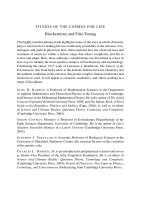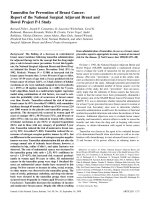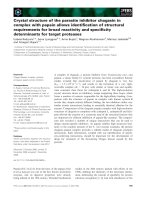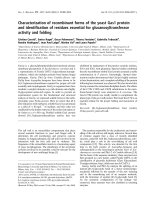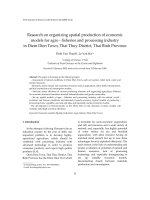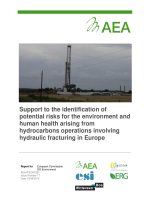Manipulation of turbulent flow for drag reduction and heat transfer enhancement 1
Bạn đang xem bản rút gọn của tài liệu. Xem và tải ngay bản đầy đủ của tài liệu tại đây (471.83 KB, 72 trang )
MANIPULATION OF TURBULENT FLOW FOR
DRAG REDUCTION AND HEAT TRANSFER
ENHANCEMENT
CHEN YU
(B. Sci., Peking University, China)
A THESIS SUBMITTED
FOR THE DEGREE OF DOCTOR OF PHILOSOPHY
DEPARTMENT OF MECHANICAL ENGINEERING
NATIONAL UNIVERSITY OF SINGAPORE
2013
Declaration
I hereby declare that this thesis is my original work and it has been
written by me in its entirety. I have duly acknowledged all the sources of
information which have been used in the thesis.
This thesis has also not been submitted for any degree in any university
previously.
CHEN YU
May 28, 2013
i
Acknowledgments
First of all, I am deeply grateful to my supervisors, Professor Yong
Tian Chew and Professor Boo Cheong Khoo, for their continuous guidance,
supervision and enjoyable discussions during this work. I also owe a debt
of gratitude to Professor K.S. Yeo, Professor J.M. Floyran, Dr. K.C. Ng,
Mr. Junhong Wang, Mr. C.M.J. Tay for their instructions and discussions.
In addition, the National University of Singapore has provided me
various supports, including the research scholarship, the abundant library
resources, and the advanced computing facilities as well as a conducive
environment, which are essential to the completion of this work.
Finally I would like to thank, from the bottom of my heart, my parents
and wife for their endless love, understanding and encouragement.
Chen Yu
ii
To my parents
To my wife Weiwei and son Xiaohan
iii
Contents
Declaration i
Acknowledgments ii
Contents iv
Summary x
List of Tables xiii
List of Figures xv
Nomenclature xxii
Chapter 1 Introduction 1
1.1 Reviewofdragreductionmethods 1
1.1.1 Passive methods 2
1.1.2 Active methods 15
1.1.3 Summary of different drag reduction methods . . . . 18
1.2 Review of heat transfer enhancement methods 18
1.2.1 Dimples . 20
iv
1.2.2 Protrusions 26
1.3 Background on turbulence 28
1.3.1 Coherentstructures 30
1.3.2 Techniques to educe the coherent structures . 35
1.4 Objectives and scope 41
1.4.1 Dragreduction 42
1.4.2 Heat transfer 43
1.4.3 Scope of present work . . 45
Chapter 2 Methodology 46
2.1 Governing equations 46
2.2 Calculationofthethermo-aerodynamicperformance 50
2.3 Numericalsimulationmethods 54
2.3.1 OnDirectNumericalSimulation 54
2.3.2 OnDetachedEddySimulation 55
2.4 Verificationofnumericalmethods 58
2.4.1 Grid independence test . . 59
2.4.2 Otherparametersandflowstructure 63
Chapter 3 Corrugated surface 70
3.1 Geometryofcorrugatedchannel 71
3.1.1 Sinusoidalgrooves 72
3.1.2 Othergrooveshapes 72
3.2 Laminar channel flow 74
3.2.1 Simplified governing equations . 74
v
3.2.2 Theoreticalsolution 75
3.2.3 Globalperformanceofdragdifference 77
3.2.4 Velocityprofile 87
3.2.5 Skinfrictiondragprofile 90
3.2.6 Analysis of interaction between bulk flow
rearrangement and skin friction distribution . 93
3.2.7 Summary . 98
3.3 Turbulent channel flow 98
3.3.1 Dragdifference 100
3.3.2 Meanvelocityprofile 105
3.3.3 Skinfrictiondragprofile 112
3.3.4 Turbulence quantities 115
3.3.5 Decompositionofdragcoefficient 124
3.3.6 Theoreticalpredictionatsmallwavenumber 128
3.3.7 Additional cases with phase shift . 131
3.3.8 Summary . 136
3.4 Concluding remarks . 137
Chapter 4 Heat transfer over asymmetric dimples 142
4.1 Configuration of asymmetric dimples . 143
4.2 Configuration of studied cases . . 146
4.3 Globalthermo-aerodynamicperformance 150
4.3.1 Symmetric dimple 150
4.3.2 Asymmetric dimple 151
4.3.3 Effect of asymmetry versus effect of depth 158
vi
4.4 Onmeancharacteristics 158
4.4.1 Meanflowfieldpatterns 160
4.4.2 Mean characteristics of drag and heat transfer . . . . 166
4.5 Instantaneouscharacteristicsofflow 173
4.5.1 Flowfield 175
4.5.2 Vortexstructures 175
4.6 Turbulent advective heat flux . . 177
4.7 Turbulent kinetic energy 180
4.8 Spectralanalysisofvelocity 181
4.9 Concluding remarks . 182
Chapter 5 Heat transfer over protrusions 186
5.1 Configurationofprotrusions 186
5.2 ResultsandDiscussion 189
5.2.1 Hydrodynamicandthermalperformance 189
5.2.2 Distribution of local drag and heat transfer rate . . . 191
5.2.3 Flowstructure 200
5.2.4 Turbulent kinetic energy . 213
5.2.5 Spectralanalysisofvelocity 213
5.3 Concluding remarks . 215
Chapter 6 Overall conclusions and recommendations 217
6.1 Conclusions 217
6.1.1 Corrugatedsurface 218
6.1.2 Heat transfer over asymmetric dimples 218
vii
6.1.3 Heat transfer over protrusions . 219
6.2 Recommendations 220
Bibliography 222
Appendix A Analytical solutions of channel with both corru-
gated walls 238
A.1 Governing equations 238
A.2 Solution 241
A.2.1 Velocityfield 241
A.2.2 Flowrate 242
Appendix B Analytical solutions of channel with single cor-
rugated wall 244
B.1 Governing equation . 244
B.2 Solution 246
B.2.1 Velocityfield 246
B.2.2 Flowrate 247
Appendix C Wetted area of corrugated channel 249
Appendix D Theoretical prediction at small wave number 251
D.1 Preparation—local friction velocity, friction Reynolds num-
ber,walllength 251
D.2 Skinfrictionprofileinthespanwisedirection 256
D.3 Velocity,fluxandfrictioncoefficient 257
D.3.1 Flatchannel 257
D.3.2 Arbitrary X-Y plane in the corrugated channel . . . . 258
viii
D.3.3 Flux—integration of bulk velocity . 260
D.3.4 Mean bulk velocity 261
D.3.5 Skinfrictioncoefficient 261
D.4 Re
τ
=180 264
D.4.1 S=0.5 264
D.4.2 S=1 265
D.4.3 Validation of results 266
D.5 Re
τ
→∞ 267
D.5.1 S=0.5 267
D.5.2 S=1 268
Appendix E Configuration of asymmetric dimple 269
Vita 274
ix
Summary
With recent advancement and globalization of economy, the demand for
energy continues to increase rapidly, resulting in severe energy crisis in
the world. To reduce the demand side of the energy equation, energy-
efficiency process/device with reduced energy wastage is essential. In
order to achieve these goals, flow manipulation technologies especially for
turbulent flow are needed to reduce drag (i.e. corrugated surface) and to
enhance thermal efficiency in heat exchangers and others (i.e. asymmetric
dimple and protrusion).
In this thesis, the drag reduction capabilities of corrugated surface were
firstly investigated using perturbation method and numerical simulations
(Direct Numerical Simulation and Detach Eddy Simulation). Additionally,
flow patterns, vortex structures, turbulent kinetic energy were examined to
reveal possible mechanisms of drag reduction. It was shown that corrugated
surface can create comparable drag reduction to (or even possibly higher
than) riblets and other traditional drag reduction devices for turbulent
channel flow. It was also found that lower wave number and higher
amplitude create more drag reduction. The corrugated surface increases
flow rate through rearranging the bulk velocity distribution or reducing
x
bulk term of drag coefficient. Study of turbulent kinetic energy (TKE)
and Reynolds stress showed that the corrugated surface rearranges the
respective distribution while keeping the volume-averaged intensity largely
unchanged. Meanwhile, the turbulent term of drag coefficient for the
corrugated surface was not obviously reduced.
The heat transfer and flow in a channel with asymmetric dimples
or protrusions on single wall were then examined by DES method. The
thermal-hydrodynamic performance of asymmetric dimple was investigated
in terms of Nussselt number, friction and performance factors. Further-
more, the distribution of friction factor and Nusselt number together with
the flow/vortex patterns over dimples/protrusions were discussed.
For the asymmetric dimple, the results showed that the skewing of the
deepest point of dimple to the downstream side while still maintaining the
circular shaped print diameter is a feasible way to enhance heat transfer
with fairly similar pressure loss. Furthermore, skewing the deepest point
of shallow dimple (h/D < 20%) in the downstream direction provides a
more efficient way to enhance heat transfer efficiency than only increasing
its depth ratio (h/D ≥ 20%). The better performance of the asymmetric
dimple is broadly attributed to its stronger flow ejection, weaker recircu-
lation zone, stronger vortices and eddies, and higher turbulent advective
heat flux.
For protrusions, it was found that larger protrusion’s height induces
higher friction factor and Nusselt number, which may be due to the
asymmetric flow features. However, when the height ratio increases, the
xi
friction factor increases more rapidly than the Nusselt number does, such
that the thermal performance factor initially increases and then reaches
its asymptotic limit or even decreases. It is also shown that the highest
friction factor and Nusselt number are co-located at the upstream portion
of protrusions due to the strong convection and impingement of fluid on
the upstream portion of protrusions. Additionally, the distributions of
friction factor and Nusselt number were symmetric and asymmetric on
the protrusion surface according to the height ratio being low and high,
respectively. This can be attributed to the symmetric and asymmetric flow
pattern and vortex structures for low and high protrusions, respectively.
xii
List of Tables
1.1 Advantages and disadvantages of the various types of active
andpassivemethodsfordragreduction 19
2.1 Grid independence test for the DNS code . 60
2.2 Domain independence test for DNS . 60
2.3 Grid independence test for the DES code . 61
2.4 Domain independence test for DES . 62
3.1 Comparison of numerical and theoretically predicted ΔD for
channel with both corrugated walls at α =2 84
3.2 Configuration of different grooves for study of wave number
and amplitude effects: ‘Y’ means it is invested by DES,
‘
†
’ means that triangular and trapezoidal grooves are also
investigated at such parameter, ‘
∗
’ means that it is also
examined by DNS . 99
3.3 Comparison of drag difference of the original shape and the
first mode in Fourier space at α =0.25 and S =1 102
3.4 Comparison of drag coefficient difference ΔD computed by
DESandDNS 102
3.5 Ratio of each term of drag coefficient to the total drag
coefficientonflatplate 126
3.6 Ratio of each term of drag coefficient on corrugated surface
tothatonflatplate 127
xiii
4.1 Different configurations of dimples for Case 2 at h/D = 10%:
‘C’ stands for the case where dimple’s deepest point is
skewed in streamwise centerline (Dz = 0%), ‘S’ stands for
the case where dimple’s deepest point is on offset side of
centerline (Dz = 15%); * stands for symmetric dimple, cases
without * are asymmetric dimples . 148
4.2 Different configurations of dimples for Case 3 at h/D = 15%.
The meanings of ‘C’, ‘S’ and * are the same as in Table 4.1 . 149
xiv
List of Figures
1.1 Top view of traditional riblets and ‘wavy riblets’ 6
1.2 Differentarrangementsof‘V’protrusions 6
1.3 Staggered sailfish skin, adapted from Sagong et al. (2008) . . 8
1.4 Different arrangement of dimples in Veldhuis and Vervoort
(2009) 11
1.5 Asymmetric dimple used by Isaev et al. (2000b) 12
1.6 Mean velocity in turbulent channel flow . 29
1.7 Instantaneous velocity field view in end view in the cross-
flow plane, adapted from Smith and Walker (1994) . 32
1.8 Scheme of the distribution of vortical structures in the
different regions of a turbulent boundary layer, adapted from
Robinson (1991) . 34
1.9 The local streamline pattern with the eigenvectors of the
velocity gradient tensor in the neighborhood of a vortex core,
adapted from Zhou et al. (1999) . 40
2.1 Computational domain for a flat channel . 47
2.2 Effects of Reynolds number on C
f
and Nu 63
2.3 Mean velocity in turbulent channel flow . 64
2.4 Mean temperature in turbulent channel flow 65
xv
2.5 Time-averaged turbulent kinetic energy components normal-
ized by u
2
τ
66
2.6 Reynolds stress
u
v
normalized by u
2
τ
66
2.7 Streamwise velocity contours (low speed streaks) in differ-
enceX-ZplaneslicesgivenbyDESandDNS 67
2.8 Resolved Reynolds stress −
u
v
and modeled Reynolds stress
ν
t
dU/dy 68
2.9 Eddy viscosity ν
t
69
3.1 Channel with (a) two corrugated walls (b) single corrugated
wall. Sinusoidal groove is taken as an example here. . 73
3.2 Sketches of the grooves used in the analysis: sinusoidal,
triangularandtrapezoidal 73
3.3 Theoretical prediction of ΔD on channel where (a) both
walls are corrugated and (b) single wall is corrugated.
Dashed lines refer to drag reduction and solid lines refer to
drag increase. Results herein is valid for α → 0 corresponds
to a corrugated channel with a very long wavelength, but
not valid for α =0 81
3.4 Theoretical prediction of ΔD on channel where (a) both
walls are corrugated (b) single wall is corrugated . Results
herein is valid for α → 0 corresponds to a corrugated channel
with a very long wavelength, but not valid for α =0 82
3.5 Ratio of theoretical ΔD for channel with both corrugated
walls versus channel with single corrugated wall. Results
herein is valid for α → 0 corresponds to a corrugated channel
with a very long wavelength, but not valid for α =0. 83
3.6 Comparison of theoretical prediction and numerical results
at α =0.5 85
xvi
3.7 Normalized wetted area difference ΔA
w
and theoretical total
drag difference ΔD for channel with both corrugated walls
at different S and α. Results herein is still valid for α → 0
corresponds to a corrugated channel with a very long wave-
length, but not valid for α =0 86
3.8 Normalized theoretical drag difference per unit wetted area
for channel with both corrugated walls at different S and
α. Results herein is still valid for α → 0 corresponds to
a corrugated channel with a very long wavelength, but not
valid for α =0 87
3.9 Streamwise velocity u on Z-Y plane: (a) α =0.5, S =0.5
(b) α =0.5, S =1(c)α =2,S =0.5(d)α =2,S = 1 (e) flat 88
3.10Normalizedsheardragoncorrugatedsurface 91
3.11 Velocity contour for α =2andS = 1 in physical domain . . 92
3.12 Force analysis in control volumes . 93
3.13 Drag coefficient difference (a) effects of α (b) effects of S . . 103
3.14 Normalized wetted area difference ΔA
w
and total drag dif-
ference ΔD at different S and α 104
3.15 Normalized drag difference per unit wetted area at different
S and α 105
3.16 Streamwise velocity u on Z-Y plane (a) α =0.25, S =0.5
(b) α =0.25, S =1(c)α =0.5, S =0.5(d)α =0.5, S =1
(e) α =2,S =0.5(f)α =2,S =1 107
3.17 Streamwise velocity u onZ-Yplaneforflatplate 107
3.18 Streamwise velocity u on unscaled Z-Y plane (a) α =0.5,
S =0.5(b)α =2,S =0.5 109
3.19 Streamwise velocity u on Z-Y plane (a) three planes position;
mean velocity on three planes for (b),(d) α =0.5, S =0.5,
(c), (e) α =2,S =0.5 110
3.20 Normalized shear drag on corrugated surface for S =0.5 . . 113
xvii
3.21 Normalized shear drag on corrugated surface for α =0.5 . . 113
3.22 Turbulent kinetic energy (TKE) in corrugated and flat chan-
nel. Three components
u
2
, v
2
and w
2
for (a)(c) α =0.5,
S =0.5 (b)(d) α =2,S =0.5; total amount
k for (e)
α =0.5, S =0.5(f)α =2,S =0.5 116
3.23 Reynolds stress (
u
v
) in corrugated and flat channel (a) α =
0.5, S =0.5(b)α =2,S =0.5 118
3.24
u
w
and v
w
in corrugated channel for (a)(c) α =0.5, S =
0.5 (b)(d) α =2,S =0.5 119
3.25 Volume averaged (a) turbulent kinetic energy (TKE)
k (b)
u
v
(c)
u
w
and
v
w
121
3.26 Turbulence structures for (a) α =0.5, S =0.5(b)α =2,
S =0.5(c)α =0.5, S =0(d)α =2,S =0 122
3.27 Body fitted orthogonal coordinate (ξ,η) established in corru-
gated channel, solid lines stand for ξ and dashed lines stand
for η 125
3.28 The drag difference ΔD at different Re
τ
and S when α → 0 130
3.29 Effects of phase shift ϕ on drag coefficient difference ΔD . . 132
3.30 Streamwise velocity u on Z-Y plane for different phase shift
(a) ϕ =0,(b)ϕ = π/2and(c)ϕ = π 135
3.31 Shear drag stress on Z-Y plane for different phase shift ϕ at
α =0.5andS =1 136
4.1 Sectional drawing of a single dimple . 144
4.2 Dimple’s surface along the streamwise centerline of dimple,
the displacement of the deepest point is ΔX = dp(−h), the
fluid flows from left to right 146
4.3 Computational domain and dimpled plate 147
4.4 Arrangement of dimples on bottom channel wall 148
4.5 Deepest point of dimple for different configurations . 149
xviii
4.6 Depth ratio effects for symmetric dimple . 152
4.7 Comparison with experimental results in Burgess and Ligrani
(2005) 153
4.8 Friction and Nusselt number ratios for Case 2 at h/D = 10% 154
4.9 Area and volume goodness factor ratios . 155
4.10 Friction and Nusselt number ratios for Case 3 at h/D = 15% 157
4.11 Depth ratio effects on asymmetric dimple’s performance . . . 159
4.12 Flow patterns for Case 2 (h/D =0.1), the fluid flows from
left to right (red dots refer to the deepest point of dimple,
thesamehereinafter) 161
4.13 Flow patterns for Case 3 (h/D =0.15), the fluid flows from
lefttoright 163
4.14 Mean streamlines patterns on X-Y plane (Z=5), the fluid
flowsfromlefttoright 165
4.15 Contours of mean vertical velocity v on X-Y plane (Z=5),
the fluid flows from left to right . 165
4.16 Contour of longitudinal velocity U in the vicinity of the
dimpled wall, the fluid flows from left to right 167
4.17 Contour of transverse velocity W in the vicinity of the
dimpled wall, the fluid flows from left to right 167
4.18 Shear stress Sm/Sm
0
for Case 3 (h/D =0.15), the fluid
flowsfromlefttoright 169
4.19 Form drag Fm/Fm
0
for Case 3 (h/D =0.15), the fluid flows
fromlefttoright 171
4.20 Nusselt number distribution for Case 3 (h/D =0.15), the
fluid flows from left to right 174
4.21 Instantaneous streamlines patterns on X-Y plane (Z=5), the
fluid flows from left to right 175
xix
4.22 Contours of instantaneous vertical velocity v on X-Y plane
(Z=5), the fluid flows from left to right . 176
4.23Vortexstructures 177
4.24 Turbulent advective heat flux
v
T
onX-Yplanes 179
4.25 Iso-surfaces of high
w
2
= 7, red dots refer to the location of
sampling point over dimples 180
4.26 Power spectral density at different angular frequency of
velocityfluctuations 181
5.1 Channelwithprotrusions 187
5.2 Sectionaldrawingofasingleprotrusion 188
5.3 Effect of h/D on Nusselt number, friction coefficient and per-
formance factors: h/D stands for height ratio for protrusion,
while it stands for depth ratio for dimple . 191
5.4 Normalized friction Sm/Sm
0
at different height ratios h/D . 193
5.5 Normalized friction Fm/Sm
0
at different height ratios h/D . 195
5.6 Normalized Nusselt number Nu/Nu
0
at different height
ratios h/D 196
5.7 Normalized skin friction Sm/Sm
0
,formdragFm/Fm
0
and
Nusselt number Nu/Nu
0
at h/D =20% 199
5.8 Streamlines on y
+
=1.5 at different height ratios h/D 201
5.9 3-D streamlines at different height ratios h/D, the dashed
line refers to the streamline tracing markers, the fluid flows
fromleftbottomcornertorighttopcorner 203
5.10 Streamlines on X-Y planes for different height ratios h/D . . 204
5.11 Velocity contours in vicinity of protrusion (y
+
=8)with
differentheightratios 205
5.12Slicespositionoverprotrusions 206
xx
5.13 Streamwise vorticity (ω
x
) and streamlines on different Z-Y
plane slices, red dashed lines refer to boundary of protrusions 209
5.14 Vortex structure identified by iso-surface of λ
2
213
5.15 Iso-surfaces of high turbulent kinetic energy
k =3,reddots
refer to the location of sampling point over high protrusion . 214
5.16 Power spectral density at different angular frequency of
velocityfluctuations 214
D.1 Mean velocity v.s. wall distance: lines are different palnes
in the corrugated channel at α =0.25 and S =0.5, symbols
are flat channel with different channel opening 254
D.2 TKE v.s. wall distance: lines are different palnes in the
corrugated channel at α =0.25 and S =0.5, symbols are
flat channel with different channel opening 255
D.3 mean velocity and TKE v.s. wall distance: lines are different
palnes in the corrugated channel at α =0.5andS =0.5,
symbols are flat channel with different channel opening . . . 255
D.4 Skin friction force ratio at S =0.5andRe
τ
=180 256
E.1 Coordinate system in 3D rendition of the dimple 270
xxi
Nomenclature
A
w
wetted surface area of channel
A
Σ
cross section area of channel
A
pro
projected area of channel wall in the X-Z plane
C
f
drag coefficient
C
fb
bulk term of drag coefficient
C
ft
turbulent term of drag coefficient
C
p
heat capacity at constant pressure
C
DES
Detached Eddy Simulation constant
d nominal diameter of dimpe/protrusion
D
discriminant of vortex or print diameter of dim-
ple/protrusion
D
x
,D
z
skewness of asymmetric dimple in X and Z directions
D
h
hydraulic diameter of channel
xxii
d
w
distance from the wall
D
p
total form drag
D
f
total skin friction drag
Ga Area goodness factor
Gv Volume goodness factor
h depth/height of dimple/protrusion
L, H, W length, half height and width of channel
k thermal conductivity or turbulent kinetic energy
Nu surface Nusselt number
p pressure
Pr Prandtl number
q constant heat flux on channel walls
Q criteria of vortex or flow rate
Re Reynolds number
Re
τ
Re based on friction velocity and half channel height
Re
2H
Re based on bulk velocity and full channel height
S amplitude of corrugated surface
xxiii
St Stanton number
Sm skin friction drag per unit projected area
Fm form drag per unit projected area
t time
Δt time step
T temperature
u, v, w velocity components in x, y and z directions
u
1
,u
2
,u
3
velocity components in x, y and z directions
u
τ
friction velocity
U
+
dimensionless mean streamwise velocity
U
b
bulk velcity
V volume of channel
x, y, z cartesian coordinates
x
1
,x
2
,x
3
cartesian coordinates
Δx, Δy, Δz grid sizes
y
+
distance to the wall in wall units
xxiv


